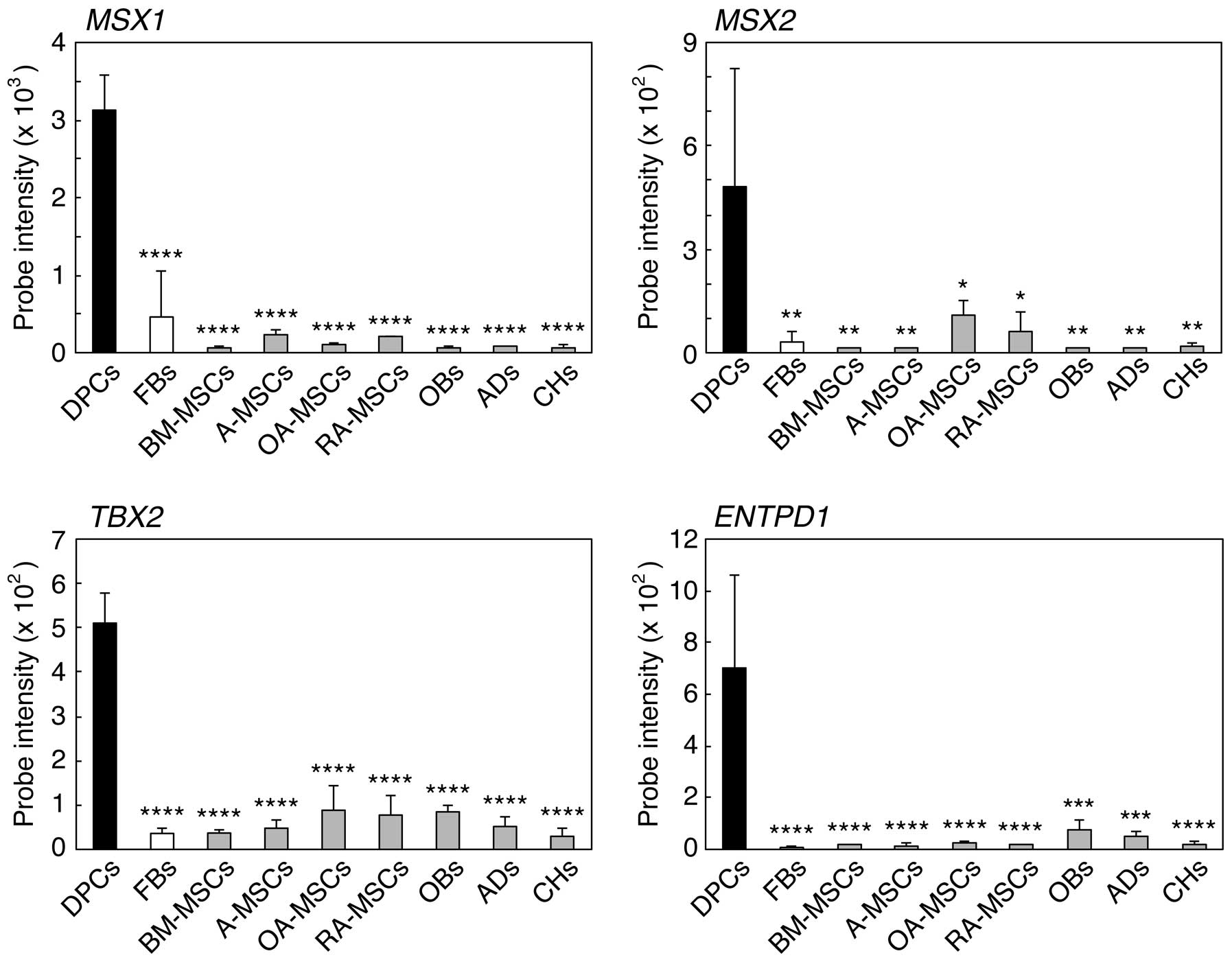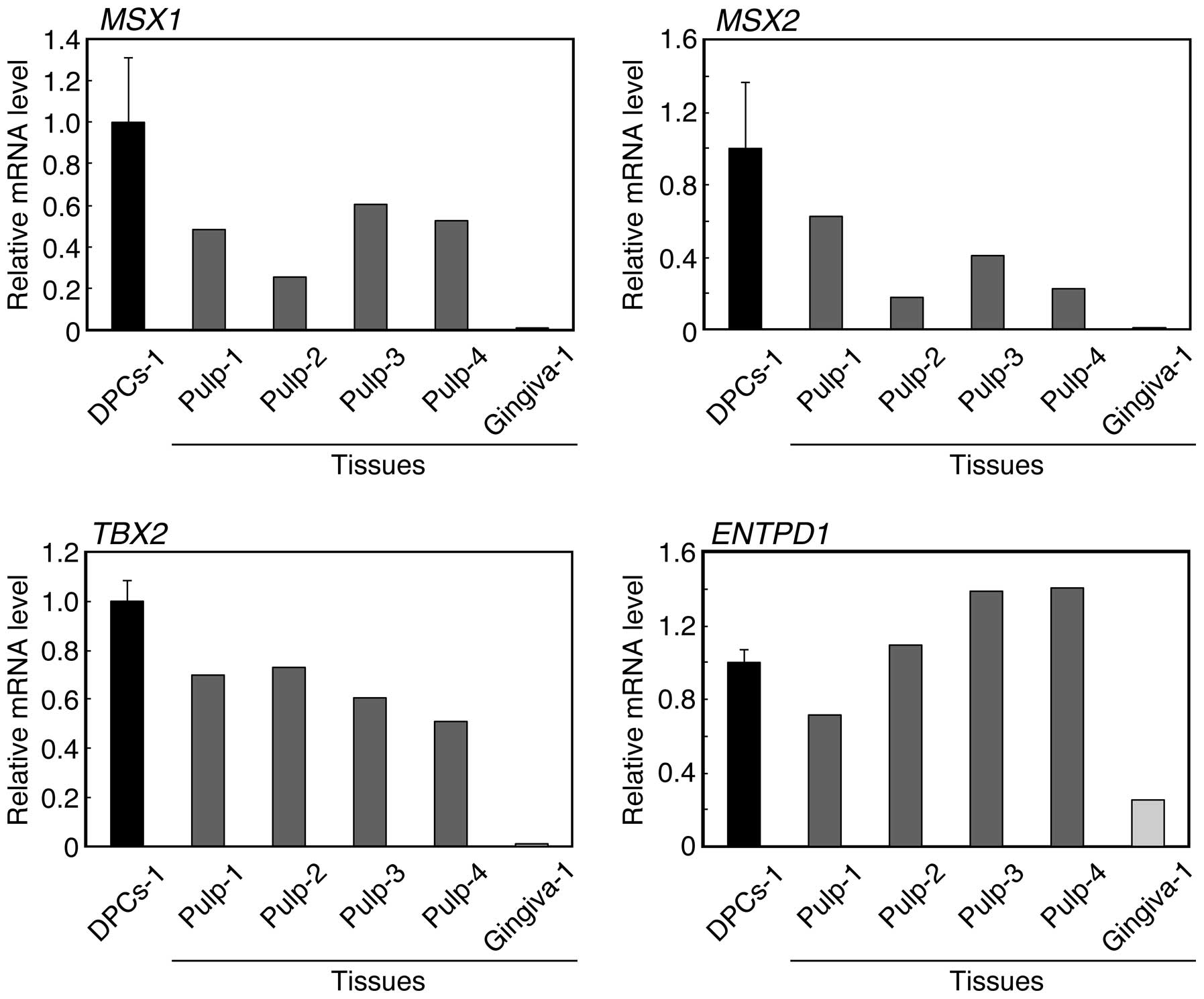|
1
|
Couble ML, Farges JC, Bleicher F,
Perrat-Mabillon B, Boudeulle M and Magloire H: Odontoblast
differentiation of human dental pulp cells in explant cultures.
Calcif Tissue Int. 66:129–138. 2000. View Article : Google Scholar : PubMed/NCBI
|
|
2
|
Min JH, Ko SY, Cho YB, Ryu CJ and Jang YJ:
Dentinogenic potential of human adult dental pulp cells during the
extended primary culture. Hum Cell. 24:43–50. 2011. View Article : Google Scholar : PubMed/NCBI
|
|
3
|
Spath L, Rotilio V, Alessandrini M,
Gambara G, De Angelis L, Mancini M, Mitsiadis TA, Vivarelli E, Naro
F, Filippini A, et al: Explant-derived human dental pulp stem cells
enhance differentiation and proliferation potentials. J Cell Mol
Med. 14:1635–1644. 2010. View Article : Google Scholar : PubMed/NCBI
|
|
4
|
Iohara K, Imabayashi K, Ishizaka R,
Watanabe A, Nabekura J, Ito M, Matsushita K, Nakamura H and
Nakashima M: Complete pulp regeneration after pulpectomy by
transplantation of CD105+ stem cells with stromal cell-derived
factor-1. Tissue Eng Part A. 17:1911–1920. 2011. View Article : Google Scholar : PubMed/NCBI
|
|
5
|
Sakai K, Yamamoto A, Matsubara K, Nakamura
S, Naruse M, Yamagata M, Sakamoto K, Tauchi R, Wakao N, Imagama S,
et al: Human dental pulp-derived stem cells promote locomotor
recovery after complete transection of the rat spinal cord by
multiple neuro-regenerative mechanisms. J Clin Invest. 122:80–90.
2012.PubMed/NCBI
|
|
6
|
Gronthos S, Mankani M, Brahim J, Robey PG
and Shi S: Postnatal human dental pulp stem cells (DPSCs) in vitro
and in vivo. Proc Natl Acad Sci USA. 97:13625–13630. 2000.
View Article : Google Scholar : PubMed/NCBI
|
|
7
|
Miura M, Gronthos S, Zhao M, Lu B, Fisher
LW, Robey PG and Shi S: SHED: Stem cells from human exfoliated
deciduous teeth. Proc Natl Acad Sci USA. 100:5807–5812. 2003.
View Article : Google Scholar : PubMed/NCBI
|
|
8
|
Jeon M, Song JS, Choi BJ, Choi HJ, Shin
DM, Jung HS and Kim SO: In vitro and in vivo characteristics of
stem cells from human exfoliated deciduous teeth obtained by
enzymatic disaggregation and outgrowth. Arch Oral Biol.
59:1013–1023. 2014. View Article : Google Scholar : PubMed/NCBI
|
|
9
|
Lee UL, Jeon SH, Park JY and Choung PH:
Effect of platelet-rich plasma on dental stem cells derived from
human impacted third molars. Regen Med. 6:67–79. 2011. View Article : Google Scholar : PubMed/NCBI
|
|
10
|
Sudo K, Kanno M, Miharada K, Ogawa S,
Hiroyama T, Saijo K and Nakamura Y: Mesenchymal progenitors able to
differentiate into osteogenic, chondrogenic and/or adipogenic cells
in vitro are present in most primary fibroblast-like cell
populations. Stem Cells. 25:1610–1617. 2007. View Article : Google Scholar : PubMed/NCBI
|
|
11
|
Fournier BP, Ferre FC, Couty L, Lataillade
JJ, Gourven M, Naveau A, Coulomb B, Lafont A and Gogly B:
Multipotent progenitor cells in gingival connective tissue. Tissue
Eng Part A. 16:2891–2899. 2010. View Article : Google Scholar : PubMed/NCBI
|
|
12
|
Kawahara K and Shimazu A: Expression and
intracellular localization of progesterone receptors in cultured
human gingival fibroblasts. J Periodontal Res. 38:242–246. 2003.
View Article : Google Scholar : PubMed/NCBI
|
|
13
|
Kubo H, Shimizu M, Taya Y, et al:
Identification of mesenchymal stem cell (MSC)-transcription factors
by microarray and knockdown analyses, and signature molecule marked
MSC in bone marrow by immunohistochemistry. Genes to cells.
14:407–424. 2009. View Article : Google Scholar : PubMed/NCBI
|
|
14
|
Tsutsumi S, Shimazu A, Miyazaki K, Pan H,
Koike C, Yoshida E, Takagishi K and Kato Y: Retention of
multilineage differentiation potential of mesenchymal cells during
proliferation in response to FGF. Biochem Biophys Res Commun.
288:413–419. 2001. View Article : Google Scholar : PubMed/NCBI
|
|
15
|
Edgar R, Domrachev M and Lash AE: Gene
Expression Omnibus: NCBI gene expression and hybridization array
data repository. Nucleic Acids Res. 30:207–210. 2002. View Article : Google Scholar : PubMed/NCBI
|
|
16
|
Chen Y, Bei M, Woo I, Satokata I and Maas
R: Msx1 controls inductive signaling in mammalian tooth
morphogenesis. Development. 122:3035–3044. 1996.PubMed/NCBI
|
|
17
|
Demenis MA, Furriel RP and Leone FA:
Characterization of an ectonucleoside triphosphate
diphosphohydrolase 1 activity in alkaline phosphatase-depleted rat
osseous plate membranes: Possible functional involvement in the
calcification process. Biochim Biophys Acta. 1646:216–225. 2003.
View Article : Google Scholar : PubMed/NCBI
|
|
18
|
Saadi I, Das P, Zhao M, Raj L, Ruspita I,
Xia Y, Papaioannou VE and Bei M: Msx1 and Tbx2 antagonistically
regulate Bmp4 expression during the bud-to-cap stage transition in
tooth development. Development. 140:2697–2702. 2013. View Article : Google Scholar : PubMed/NCBI
|
|
19
|
Yoshizawa T, Takizawa F, Iizawa F,
Ishibashi O and Kawashima H, Matsuda A, Endo N and Kawashima H:
Homeobox protein MSX2 acts as a molecular defense mechanism for
preventing ossification in ligament fibroblasts. Mol Cell Biol.
24:3460–3472. 2004. View Article : Google Scholar : PubMed/NCBI
|
|
20
|
da Silva Meirelles L, Chagastelles PC and
Nardi NB: Mesenchymal stem cells reside in virtually all post-natal
organs and tissues. J Cell Sci. 119:2204–2213. 2006. View Article : Google Scholar : PubMed/NCBI
|
|
21
|
Shi S, Robey PG and Gronthos S: Comparison
of human dental pulp and bone marrow stromal stem cells by cDNA
microarray analysis. Bone. 29:532–539. 2001. View Article : Google Scholar : PubMed/NCBI
|
|
22
|
Hung CN, Mar K, Chang HC, Chiang YL, Hu
HY, Lai CC, Chu RM and Ma CM: A comparison between adipose tissue
and dental pulp as sources of MSCs for tooth regeneration.
Biomaterials. 32:6995–7005. 2011. View Article : Google Scholar : PubMed/NCBI
|
|
23
|
Bensoussan-Trigano V, Lallemand Y, Saint
Cloment C and Robert B: Msx1 and Msx2 in limb mesenchyme modulate
digit number and identity. Dev Dyn. 240:1190–1202. 2011. View Article : Google Scholar : PubMed/NCBI
|
|
24
|
Chen J, Zhong Q, Wang J, Cameron RS, Borke
JL, Isales CM and Bollag RJ: Microarray analysis of Tbx2-directed
gene expression: A possible role in osteogenesis. Mol Cell
Endocrinol. 177:43–54. 2001. View Article : Google Scholar : PubMed/NCBI
|
|
25
|
Verhoeven MC, Haase C, Christoffels VM,
Weidinger G and Bakkers J: Wnt signaling regulates atrioventricular
canal formation upstream of BMP and Tbx2. Birth Defects Res A Clin
Mol Teratol. 91:435–440. 2011. View Article : Google Scholar : PubMed/NCBI
|
|
26
|
Farin HF, Lüdtke TH, Schmidt MK, Placzko
S, Schuster-Gossler K, Petry M, Christoffels VM and Kispert A: Tbx2
terminates shh/fgf signaling in the developing mouse limb bud by
direct repression of gremlin1. PLoS Genet. 9:e10034672013.
View Article : Google Scholar : PubMed/NCBI
|
|
27
|
Yamada Y, Fujimoto A, Ito A, Yoshimi R and
Ueda M: Cluster analysis and gene expression profiles: A cDNA
microarray system-based comparison between human dental pulp stem
cells (hDPSCs) and human mesenchymal stem cells (hMSCs) for tissue
engineering cell therapy. Biomaterials. 27:3766–3781. 2006.
View Article : Google Scholar : PubMed/NCBI
|
|
28
|
Drosopoulos JH, Broekman MJ, Islam N,
Maliszewski CR, Gayle RB III and Marcus AJ: Site-directed
mutagenesis of human endothelial cell ecto-ADPase/soluble CD39:
Requirement of glutamate 174 and serine 218 for enzyme activity and
inhibition of platelet recruitment. Biochemistry. 39:6936–6943.
2000. View Article : Google Scholar : PubMed/NCBI
|
|
29
|
Pulte ED, Broekman MJ, Olson KE,
Drosopoulos JH, Kizer JR, Islam N and Marcus AJ: CD39/NTPDase-1
activity and expression in normal leukocytes. Thromb Res.
121:309–317. 2007. View Article : Google Scholar : PubMed/NCBI
|
|
30
|
Zhou Q, Yan J, Putheti P, et al: Isolated
CD39 expression on CD4 T cells denotes both regulatory and memory
populations. Am J Transplant. 9:2303–2311. 2009. View Article : Google Scholar : PubMed/NCBI
|
|
31
|
Orriss IR, Burnstock G and Arnett TR:
Purinergic signalling and bone remodelling. Curr Opin Pharmacol.
10:322–330. 2010. View Article : Google Scholar : PubMed/NCBI
|













